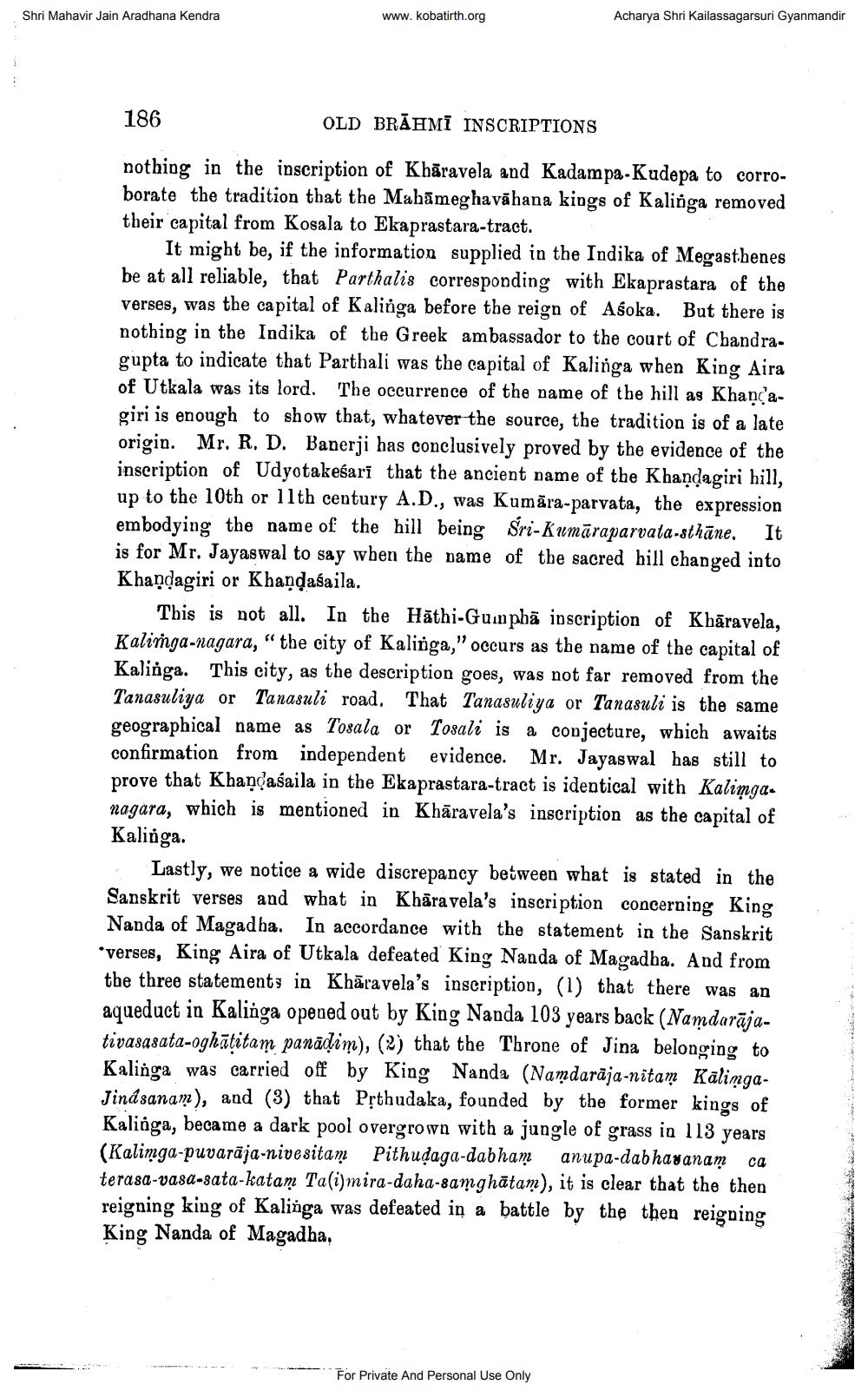________________
Shri Mahavir Jain Aradhana Kendra
www.kobatirth.org
Acharya Shri Kailassagarsuri Gyanmandir
186
OLD BRĀHMĪ INSCRIPTIONS
nothing in the inscription of Khāravela and Kadampa-Kudepa to corroborate the tradition that the Mahāmeghavāhana kings of Kalinga removed their capital from Kosala to Ekaprastara-tract.
It might be, if the information supplied in the Indika of Megasthenes be at all reliable, that Parthalis corresponding with Ekaprastara of the verses, was the capital of Kalinga before the reign of Asoka. But there is nothing in the Indika of the Greek ambassador to the court of Chandra. gupta to indicate that Parthali was the capital of Kalinga when King Aira of Utkala was its lord. The occurrence of the name of the hill as Khanc'agiri is enough to show that, whatever the source, the tradition is of a late origin. Mr. R. D. Banerji has conclusively proved by the evidence of the inscription of Udyotakeśarī that the ancient name of the Khandagiri hill, up to the 10th or 11th century A.D., was Kumāra-parvata, the expression embodying the name of the hill being Sri-Kumāraparvata-sthāne. It is for Mr. Jayaswal to say when the name of the sacred hill changed into Khandagiri or Khandaśaila.
This is not all. In the Hāthi-Gumphā inscription of Khāravela, Kalimga-nagara," the city of Kalinga," occurs as the name of the capital of Kalinga. This city, as the description goes, was not far removed from the Tanasuliya or Tanasuli road. That Tanasuliya or Tanasuli is the same geographical name as Tosala or Tosali is a conjecture, which awaits confirmation from independent evidence. Mr. Jayaswal has still to prove that Khandaśaila in the Ekaprastara-tract is identical with Kalimga. nagara, which is mentioned in Khāravela's inscription as the capital of Kalinga.
Lastly, we notice a wide discrepancy between what is stated in the Sanskrit verses and what in Khāra vela's inscription concerning King Nanda of Magadha. In accordance with the statement in the Sanskrit •verses, King Aira of Utkala defeated King Nanda of Magadba. And from the three statements in Khāravela's inscription, (l) that there was an aqueduct in Kalinga opened out by King Nanda 103 years back (Namdarājativasasata-oghātitam panādim), (2) that the Throne of Jina belonging to Kalinga was carried off by King Nanda (Namdarāja-nitam KālimgaJindsanam), and (3) that Pșthudaka, founded by the former kings of Kalinga, became a dark pool overgrown with a jungle of grass in 113 years (Kalimga-puvarāja-nivesitam Pithudaga-dabham anupa-dabhavanam ca terasa-vasa-sata-katam Ta(i)mira-daha-samghātam), it is clear that the then reigning king of Kalinga was defeated in a battle by the then reigning King Nanda of Magadha,
For Private And Personal Use Only




